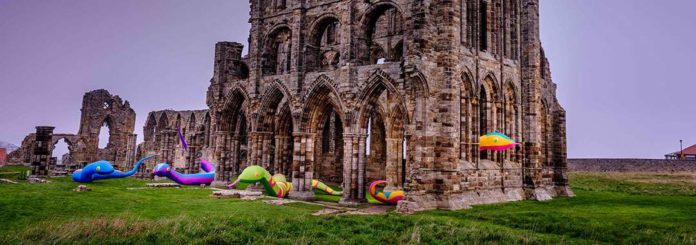Whitby Abbey, the imposing ruin overlooking the North Yorkshire coast, has re-opened to the public following a major £1.6 million re-interpretation project by English Heritage – including a new museum and new interpretation around the historic site.
To celebrate the re-opening, and as part of English Heritage’s Telling Tales season, the charity has re-imagined a famous legend associated with Whitby, the abbey and its founder, St Hild. A temporary installation of giant inflatable snakes will evoke how Hild dealt with a plague of snakes in the abbey by driving them over the cliff. The snakes smashed their heads in the fall and were miraculously turned into stone.
Visitors to Whitby today can see the remains of these ‘petrified’ snakes on the town’s beaches (in reality, ammonite fossils).
Andrea Selley, English Heritage’s Director for the North, said:
‘Whitby Abbey was one of the most important religious centres in the world and the decisions made there continue to shape our lives today. We’ve now done justice to the abbey’s remarkable stories, from its role in deciding the future of the Church in England to how its ruins inspired great artists and authors.
‘A visit to Whitby just wouldn’t be complete without exploring the abbey and the changes we’ve made there – including a new entrance, the revamped museum, and the new café – will ensure that visitors get a warm welcome at this Yorkshire icon.’
Founded in the 7th century, Whitby Abbey was one of the most important religious centres in the Anglo-Saxon world.
In 664 it was the setting for the Synod of Whitby, a landmark in the history of the Church in England. It was here that the rivalry between the two strands of Christianity in England, the Hiberno-Scottish and the Roman, came to a head. Christianity had been brought to Northumbria not only by missionaries from Rome but by Irish missionaries from Iona in Scotland. The two traditions differed over such issues as how priests and monks should wear their hair and, most significantly, how the date of Easter should be calculated.
Gathering the two sides at Whitby Abbey, King Oswiu heard both arguments and decided that the Roman side should prevail. England forged strong religious and cultural links with mainland Europe and the papacy in Rome that endured until the Reformation of Henry VIII when Whitby was reduced to ruins. The method of calculating Easter – as decided at Whitby – is still used to this day.
Whitby Abbey has also provided inspiration for many notable artists and authors including Cædmon, the first named poet in the English language, JMW Turner, and Bram Stoker, whose 1890 visit to the town and abbey inspired his most famous work, Dracula. The novel’s publication in 1897 gave Whitby a major literary association, ensuring that the sinister count would forever be linked with the seaside town.







